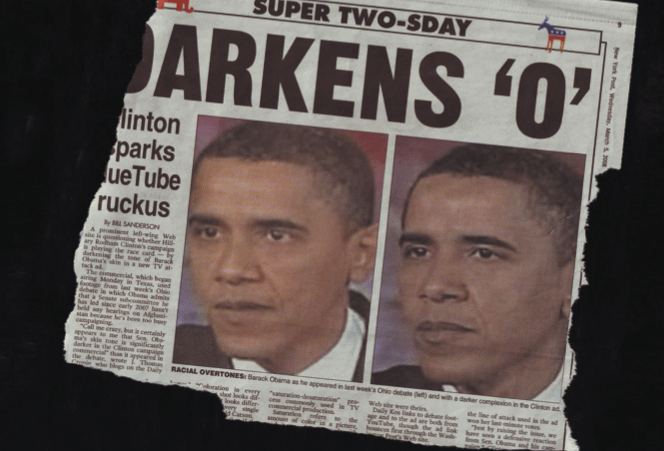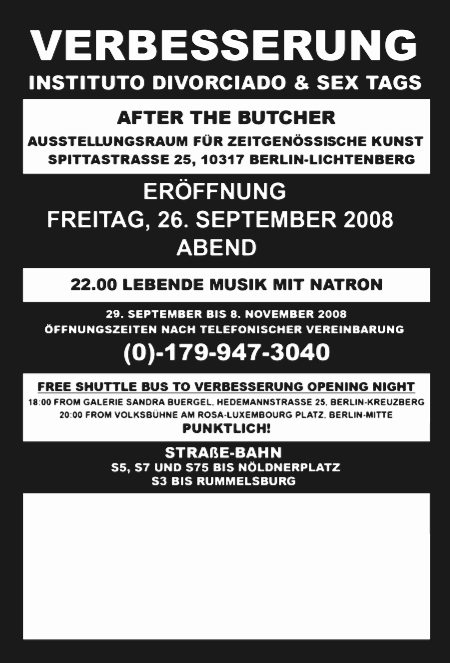Istituto Divorciado & Sex Tags
September 26, 2008 – from 6pm
Exhibition: September, 29th – November, 8th 2008
FREE SHUTTLE BUS TO VERBESSERUNG OPENING NIGHT
departing at 6pm from Galerie Sandra Buerguel, Hedemannstraße 25, Kreuzberg
then at 8pm from Volksbühne am Rosa-Luxemburg-Platz, Mitte
PUNKTLICH! 22:00 uhr lebende musik mit NATRON
see Verbesserung infomercial video at KIM’s window
Brunnenstraße 10, 10119 Berlin


IMPROVEMENT
BY CORDULA DAUS
Often a small improvement precedes a great vision. Only for four days tiredly flew the flag of the United States of Brasil at the mast in November 1889, a green and yellow imitation of the northern Stars and Stripes, until Raimundo Teixeira Mendes designed a better one, after sketches by Auguste Comte. Since then a banderole with the positivistic credo “order and progress” is floating across the blue globe before the southern starry sky. A slogan that today could be easily improved. The rainbow flag however is an often varied symbol for diversity: Already the Incas have used it, their colours also symbolize the Jewish autonomous territory or stand for tolerance and sexual freedom. VERBESSERUNG shows even an entire rainbow machine – the trace of an action which paint has etched into the wall.
Instituto Divorciado and Sex Tags have created a veritable Wunderkammer for their show at After the Butcher in which the big and small scenarios of improvement meet and collide: political utopias and their catastrophes, time tunnel, egg-sorcisms, do-gooders and DIYers, bondage and de-bondage artists, deloused gals, obscene kangaroos and a self-reading books.
There is something hopeless to the idea of improving… There lurks the pettiness of correction, the wrecked optimism of the before-after. Where you have to improve something is not alright.
“The world becomes old and young again, but man hopes are always bettering” in 1797 Friedrich Schiller wrote. In 2007, Cheeta the chimpanzee becomes 75 years old and beats all records as oldest great ape, meanwhile in the industrialized countries people have an average lifespan of 80 years thanks to improved medical health care. Indeed the semantic field of the bettering ranges from zoological quality management, via personal well-wishing, to social, political and even global issues. But how about improvements within the arts?
Improvement in relation to art is irritating because it implies a measurability that, within the irrational area of aesthetics, art markets and their verdicts of taste, it seems to be out of place. Who improves what, wherefore and in what sense? At the latest since Hegel’s famous thesis of the end of art we could argue that art is free from its sacred mission and its belief in an upper — only artisticly presentable — truth and can address itself to the “lively presence”.
If art does not function anymore as a general ethical authority instance – which could then be compared with the normative notion of improvement? If at all, how could art improve without getting trapped in the rhetoric of the conditioners? And how would im- proved art look like?
In April 2009 the exhibition “Wir verbessern ihr Arbeit” (“we improve your artwork”) will follow at Galerie Sandra Buergel. Then Instituto Divorciado will intervene in the works of the invited artists. Sort of an encroaching curatorial approach — not only author — ship but the criteria for “good” art is at stake. “Give us your art and we’ll improve it”. A pragmatical service that spurns all metaphysics and promises to free the participating artists from their own work and ego. So forth with your art!